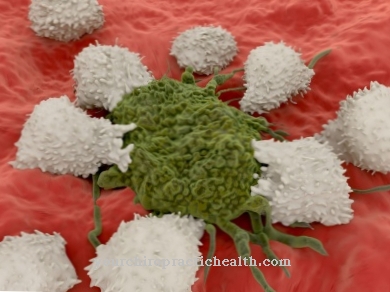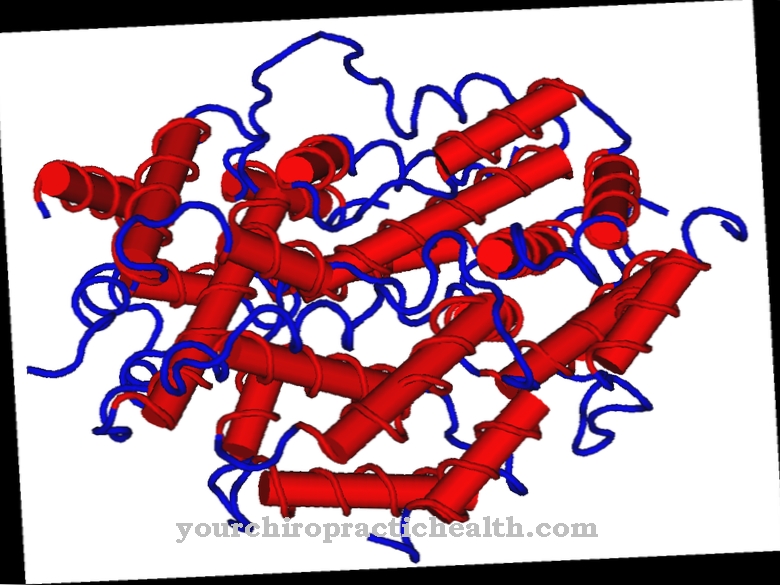B lymphocytes (B cells) are white blood cells (leukocytes) and are the only cells that can produce antibodies. If activated by foreign antigens, they differentiate into memory cells or plasma cells.
What are B lymphocytes?
B-lymphocytes are assigned to the group of white blood cells. Their most important task is the formation of antibodies.
The lymphocyte type was discovered for the first time in birds; in humans, B cells are formed in the bone marrow and in the fetal liver.B lymphocytes make up about five to ten percent of the lymphocytes that circulate in the blood. They are mainly found in the bone marrow, lymph nodes, spleen and lymph follicles.
Function, effect & tasks
The human immune system can be divided into three parts:
- Surface barriers such as skin or mucous membranes
- internal defenses against inflammation and fever
- adaptive defenses
The adaptive defenses include the T lymphocytes and B lymphocytes, whereby these defense mechanisms can be divided into cell-mediated and humoral immunity. B-lymphocytes play an essential role in the immune system. The term B cell comes from the English term "bone marrow", which means something like bone marrow. If there is contact with an exogenous pathogen, so-called immune globulins are formed in the B lymphocytes.
An antibody is produced against each antigen, with the B lymphocytes mainly concentrating on toxins and bacteria. Antibodies are special proteins that can be found in various body fluids. Antibodies protect the body from:
- Viruses
- Bacteria, fungi
- Foreign and tumor tissue
- Animal poisons
- Bee pollen
- artificial and natural substances
If the B lymphocytes divide, plasma cells are formed. Some of them only exist for a few weeks, others are memory cells and remain in the human body for years. These are also called memory B cells.
In addition, based on their function, the B lymphocytes are also divided into plasmablasts or naive B cells. Plasmablasts are activated B-lymphocytes, whereas non-activated B-cells can be found in the lymphatic system or in the bloodstream. If they perceive an antigen, it is absorbed and subsequently released as a protein complex.
Education, occurrence, properties & optimal values
First, a mature B-lymphocyte circulates in the bloodstream as well as in the lymphatic system. If it comes into contact with an antigen, it is bound to the B-cell receptor. This process is called receptor-mediated endocytosis. The antigens can then get into the acidic cell compartments, where they are split into peptides. Then it is transported to the cell surface.
However, the binding alone is not sufficient for activation of the B lymphocytes. The B lymphocyte can only be activated and antibodies formed if the antigen is also recognized as foreign by a T helper cell. Basically, B cells need two signals for activation. You get the first through the binding of the receptor, the second through the binding of CD4oL to CD40. After activation, the B-lymphocyte reaches the nearest lymph node, where it differentiates into plasma cells.
These then form antibodies. Plasma cells are oval to spherical in shape, their nucleus is usually eccentric and they are strongly basophilic. Mature plasma cells can be found in the spleen, bone marrow, lymph node marrow, exocrine glands, mucous membranes and chronic inflammation centers.
A smaller proportion develop into B memory cells, which circulate in the lymphatic system or in the blood even after an infection has been warded off. If an antigen enters the body again, the immune reaction is faster because the blueprint for the corresponding antibodies is already known. The information about the structure of the antibodies can be found in the DNA of the B lymphocytes. Since the human body comes into contact with billions of different antigens, there are also a wide variety of lymphocyte clones that have different DNA codes.
In addition to the different final and maturity stages of B lymphocytes, there are basically two types of B cells: B2 cells are referred to as "ordinary" B cells, while B1 cells are larger and mainly occur in the abdominal cavity. These cells are not present in the peripheral lymph nodes. In addition, they differ from the B2 cells in certain surface markers.
Diseases & Disorders
An increase in B-lymphocytes can be found in the following diseases:
- certain infectious diseases
- Autoimmune diseases
- B-cell lymphomas (for example, chronic lymphocytic leukemia)
Lower values, however, occur in the following diseases:
- Liver disease
- Iron deficiency
- Immunodeficiency
As part of a B-cell lymphoma, a group of lymphocytes multiplies at one point in the body, which is also known as clonal growth. It is possible that the disease is limited to lymphatic tissue, but the lymphocytes can also enter the blood, in which case what is known as lymphatic leukemia is spoken of. There are two groups of lymphomas:
- Non-Hodgkin lymphoma (NHL)
- Hodgkin lymphoma
Non-Hodgkin's lymphomas can in turn be subdivided into B-cell NHL and T-cell NHL. B-cell lymphomas include, for example:
- Immunocytomas
- multiple myelomas
- chronic lymphocytic leukemia
Chronic lymphocytic leukemia occurs very frequently, with the following symptoms:
- general weakness
- Rashes, itching
- Swelling of the lymph nodes
- Enlargements of the liver and spleen
























.jpg)



